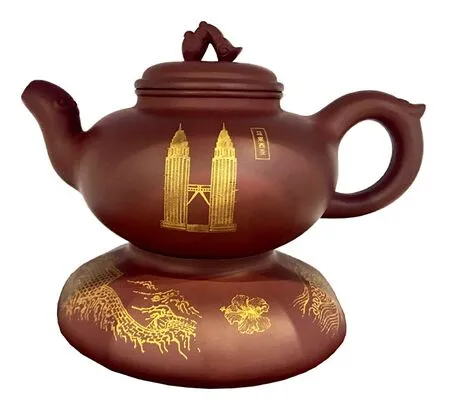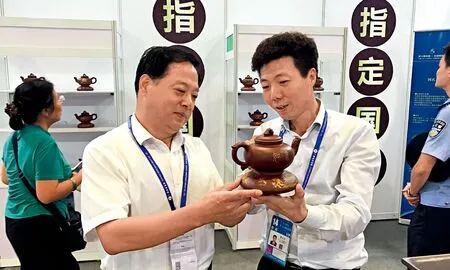POTTERY SHOWCASES CHINA-ASEAN FRIENDSHIP
By Wang Fang
Rich in cultural symbolism, gifts for state guests at the 14th China-ASEAN Expo show closeness of regional ties
POTTERY SHOWCASES CHINA-ASEAN FRIENDSHIP
By Wang Fang
Rich in cultural symbolism, gifts for state guests at the 14th China-ASEAN Expo show closeness of regional ties

Ru Yi Malaysia Teapot

Ru Yi Brunei Teapot
“Gifts for state guests are a kind of cultural exchange, through which Chinese culture will spread to ASEAN countries and the world at large.”
Gifts for state guests embody the highest level of courtesy that China gives to foreign heads of state and highranking government officials.The year 2017 marks not only the 50th anniversary of the establishment of ASEAN but also the China-ASEAN Year of Tourism Cooperation.Therefore, the designated gift for state guests at the 14th China-ASEAN Expo(CAEXPO),held from Sept. 12-14 in Nanning,capital of south China’s Guangxi Zhuang Autonomous Region, has attracted much attention.
As a gift presented to state guests represents the image of a country, it can also act as a keepsake of cultural exchange.Through strict selection, the CAEXPO secretariat eventually selected Cao Anxiang, a Chinese craft master of darkred enameled pottery, to design and create the gift presented to state guests at the expo this year. At the 14th CAEXPO, Cao displayed a series of dark-red enameled pottery teapots with meaningful and appealing designs, and Cao named this series “Ru Yi”, or “as you wish”in English.
What is the meaning behind the pottery series? What is the story behind their creation?China Report ASEAN invited Cao Anxiang for an interview with these questions and more in mind.
Unique Creative Ideas
“I started competitive bidding three months ago, and my creative ideas won recognition from the CAEXPO secretariat,” Cao said. Selecting a gift for state guests has to go through rounds of screening and can be finalized only after extensive consultation,evaluation and detail adjustment.
For Cao, the difficulty of crafting the dark-red enameled pottery gifts lies in using elements such as shape,ornamentation and craft to reflect the theme of this year’s CAEXPO, “Co-building the 21st Century Maritime Silk Road,Promoting Regional Economic Integration through Tourism”.

Cao Anxiang(right) holds one of the darkred enameled pottery teapots that he made for state guests attending the 14th CAEXPO.
“I designed dozens of alternatives based on the theme, and spent nearly three months working on 11 different pieces,” Cao said. He worked to integrate Chinese elements including traditional culture and symbolic clouds,dragons, the Great Wall and the Goddess Mazu into the design and production of the items.Dark-red enameled pottery is the essence of Chinese culture. The ornamentation of these particular pieces adopts auspicious clouds to indicate good luck and happiness.“The ruyi [an S-shaped ornamental object often used as a symbol of good luck] lid represents safety on the sea,a blessing for the rejuvenation of the Maritime Silk Road,”Cao said. The teapot handle takes on an altered shape of ruyi indicating both good luck and success in China-ASEAN relations. The shape of the pottery body and base is round,indicating that all people under the sun are of one family.
Cao crafted 11 different pieces, symbolizing the 10 ASEAN member states plus China.
The design of the teapot body was customized for each piece. For instance, “Ru Yi Dragon Teapot” shows clouds and ships used during Chinese admiral Zheng He’s seven voyages to the western oceans between 1405 and 1433, as well as a dragon-shaped pottery spout and a dragon tail-shaped teapot handle. Each of the remaining pieces shows unique architecture or landmarks from ASEAN member states.The ornamentation of the teapot base shows the Great Wall and ocean waves,symbolizing China and ASEAN countries jointly constructing a community of shared future in multiple fields on the basis of consensus on cooperation in the Silk Road Economic Belt and the 21st Century Maritime Silk Road.
Messenger of Friendly Exchanges
“These pieces are similar in shape, but there are subtle differences,” Cao said.This not only represents the traditional Chinese philosophical concept of“harmonious yet different”,but also reflects the theme of win-win cooperation between China and ASEAN countries, as well as their close partnership.
“I have been to Yixing [a county-level city in southern Jiangsu Province] three times,” said Chen Baoxuan,the official in charge of the state gift selection. “The city has a population of just over 1 million, but the number of teapot makers living there is more than 100,000. There are tens of thousands of potterymaking workshops in the city, so selecting an authentic potterymaking master is no easy task.”
In the end, Chen chose Cao because of his 30 years of experience in making incense burners, as well as Cao’s perseverance and his pursuit of and belief in Confucianism,Taoism and Buddhism.
Apart from Cao’s “Ru Yi”teapots, gifts presented to state guests at the 14th CAEXPO also included “Colorful Peafowl”commemorative tea from Yunnan Province, a “Yi Fan Feng Shun” (plain sailing) ship model from the Guangxi Pearl Royal Investment Holding Group and “Hua Kai Xiang”(auspicious flowers) brooches of national flowers from China and 10 ASEAN member states.
“Gifts for state guests are a kind of cultural exchange between two countries, through which Chinese culture will spread to ASEAN countries and the world at large,” Cao said.
- China Report Asean的其它文章
- CHINESE SHARED BIKES HIT SOUTHEAST ASIAN STREETS
- BOZHOU: WORLD CAPITAL OF TRADITIONAL CHINESE MEDICINE
- FOREIGNERS BENEFIT FROM NEW ADMINISTRATIVE SERVICES IN RUILI
- TOURISM BOOMS IN BORDER REGION
- MULTI-FACETED APPROACH FOR HUAWEI IN THE PHILIP
- ETHNIC CHINESE ENTREPRENEURSFOCUS ON MYAN

